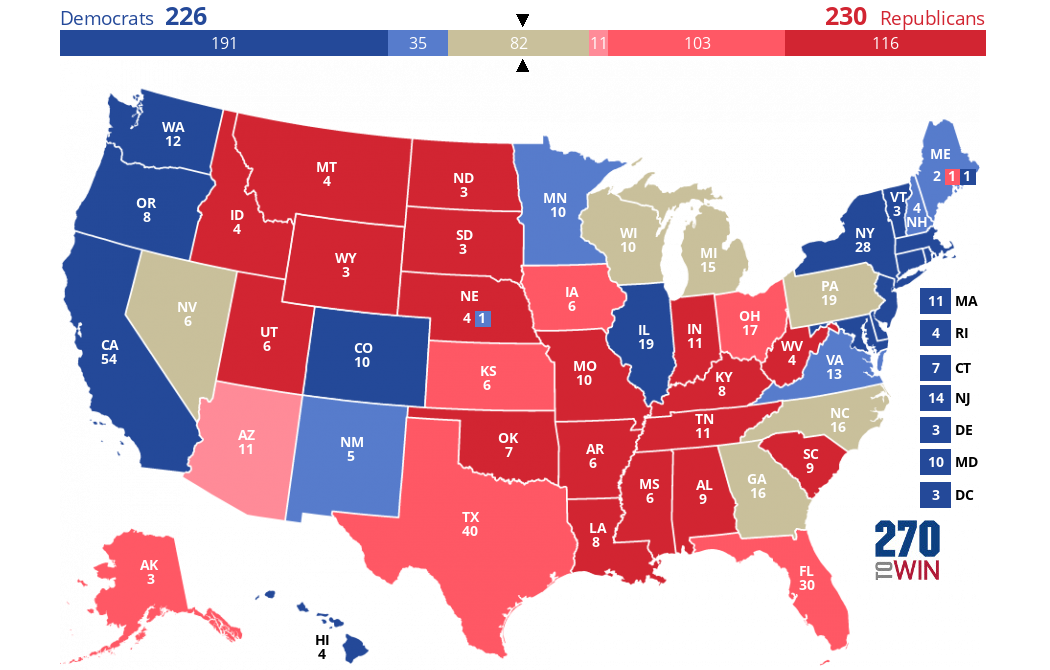Here are the current consensus forecast maps for Senate, House and Governor. Click or tap any of these maps for an interactive version. On those pages, you can also view a timeline - see the controls above the map - of how the consensus has shifted over time.
Election News
Senate Polling Averages as of October 24
By 270toWin Staff - October 24, 2022, 3:25 PM ET
The information on this page is current as of 3:00 PM Eastern Time on October 24. Select a state in the table to see the latest average as well as individual poll detail.
Some forecasters moved the Iowa and Washington Senate races out of the 'safe' category after the release of fresh polling data. There have been no other changes to the consensus forecast; 22 of this year's 35 U.S. Senate seats up for election are seen as safe for the incumbent party. That includes 14 of 21 GOP-held seats, and nine of 8 held by Democrats. Assuming those play out as expected, Democrats1 1Includes independents in Maine and Vermont that caucus with the party. will hold 44 seats, Republicans 43.
The other 13 seats feature varying levels of competitiveness, according to the consensus. The table below lists those states, ordered by the 270toWin polling average margin between the two major party candidates.
Three Weeks Out: Updated Senate Polling Averages for Competitive Elections
By 270toWin Staff - October 18, 2022, 3:28 PM ET
The information on this page is current as of 3:00 PM Eastern Time on October 18. Select a state in the table to see the latest average as well as individual poll detail.
There have been no changes to the consensus forecast since we published this table last week: 24 of this year's 35 U.S. Senate seats up for election are seen as safe for the incumbent party. That includes 15 of 21 GOP-held seats, and nine of 14 held by Democrats. Assuming those play out as expected, Democrats1 1Includes independents in Maine and Vermont that caucus with the party. will hold 45 seats, Republicans 44.
The other 11 seats feature varying levels of competitiveness, according to the consensus. The table below lists those states, ordered by the 270toWin polling average margin between the two major party candidates.
Sen. Grassley Lead Narrows in Latest Survey by Highly-Rated Iowa Pollster
By 270toWin Staff - October 17, 2022, 10:26 AM ET
Sen. Chuck Grassley is narrowly ahead of Democrat Mike Franken, according to the latest Des Moines Register Iowa Poll. The Republican, seeking his 8th term, led Franken by three points, 46% to 43%. The survey, of 620 likely Iowa voters, has a margin of error of 3.9%. It was conducted by Selzer & Company, rated A+ by FiveThirtyEight.
We don't often highlight individual polls, particularly those that seem to be outliers. Grassley led by double-digits in two other recent polls, and most forecasters don't have this race on the competitive radar.
However, what caught our eye was that the same survey found Republican Gov. Kim Reynolds with a 17% lead over her Democratic challenger, Deidre DeJear. That result was pretty much right in line with other polls of the gubernatorial race.
2022 Senate Elections: Current Polling Averages and Consensus Rating
By 270toWin Staff - October 12, 2022, 12:35 PM ET
The information on this page is current as of noon Eastern Time on October 12. Select a state in the table to see the latest average as well as individual poll detail.
Based on the consensus forecast, 24 of this year's 35 U.S. Senate seats up for election are seen as safe for the incumbent party. That includes 15 of 21 GOP-held seats, and nine of 14 held by Democrats. Assuming those play out as expected, Democrats1 1Includes independents in Maine and Vermont that caucus with the party. will hold 45 seats, Republicans 44.
The other 11 seats feature varying levels of competitiveness, according to the consensus. The table below lists those states, ordered by the 270toWin polling average margin between the two major party candidates.
Nebraska Sen. Ben Sasse Expected to Resign; Sole Finalist to be President at University of Florida
By 270toWin Staff - October 6, 2022, 4:42 PM ET

Nebraska Sen. Ben Sasse is expected to resign in the near future, likely to become the new president at the University of Florida. He is the only finalist in that search. Per Politico, Sasse, in his second term, has "made a name for himself as a consistent Trump critic in Congress as well as a reliable conservative vote."
With the planned departure coming so close to the 2022 election, Gov. Pete Ricketts (R) will be able to appoint an interim replacement, who will serve until a special election is held in November, 2024. The winner of that election will complete the final two years of the term. Nebraska's other Senate seat, held by Republican Deb Fischer will also be on the 2024 ballot for a regular six-year term.
Florida Democratic Rep. Ted Deutch Resigning at Close of Business Friday
By 270toWin Staff - September 30, 2022, 2:15 PM ET
Friday will be the final day in the U.S. House for Rep. Ted Deutch (FL-22). The Florida Democrat had announced earlier this year that he would not seek reelection, and would depart before the end of the term. He is moving to a new role as CEO of the American Jewish Committee.
Barring any unexpected changes, Democrats will hold a 220-212 edge over Republicans through the November 8 general election. On that date, there will be a special election to fill the vacancy in Indiana's 2nd District. The seat became open when Jackie Walorski (R) died in an automobile accident in early August. Republicans are expected to hold the seat, making the partisan composition 220-213 for the lame duck period.
The other two open seats, both in Florida, will not be filled until the start of the new Congress in January. In addition to Deutch's district, Charlie Crist resigned from the 13th District at the end of August to focus on his general election campaign against Republican Gov. Ron DeSantis.
Polling Update: September 27
By 270toWin Staff - September 27, 2022, 5:56 PM ET
Today marks 42 days - six weeks - until the 2022 midterm elections.
Introducing the 2022 House Simulator
By 270toWin Staff - September 19, 2022, 9:53 AM ET
Today marks 50 days until the November 8 midterm elections. To mark the occasion - although the timing is really just a coincidence - we've launched the 2022 House Simulator.
Run as many simulated elections as you'd like for the 435 U.S. House seats up this year. The results of a simulation can be displayed randomly, or in order of poll closing times. A table below the map will track your simulations until the browser tab is closed.
Democrats narrowly control the chamber, with a 221-212 edge over Republicans. Assigning the two vacancies (FL-13 and IN-02) to the prior incumbent party gives us a 222-213 count at full strength. Republicans will need to gain five seats in November to take back the Speaker's gavel.
Uncontested: The 35 House Districts With Only One Major Party on the Ballot
By 270toWin Staff - September 15, 2022, 1:38 PM ET
Updated to remove PA-15 Republican Glenn Thompson from the 'Totally Unopposed' List. Numbers have been updated in the article, as applicable.
As this year's primaries (view results by state) draw to a close, we count 35 U.S. House races where only one of the two major parties will be on the ballot. 23 of these are held by Republicans, 12 by Democrats.
16 incumbents have no opponent. In 13 other districts, opposition is from a 3rd party or independent candidate. Finally, in six California districts, Democrats won both positions in the top-two primary.

